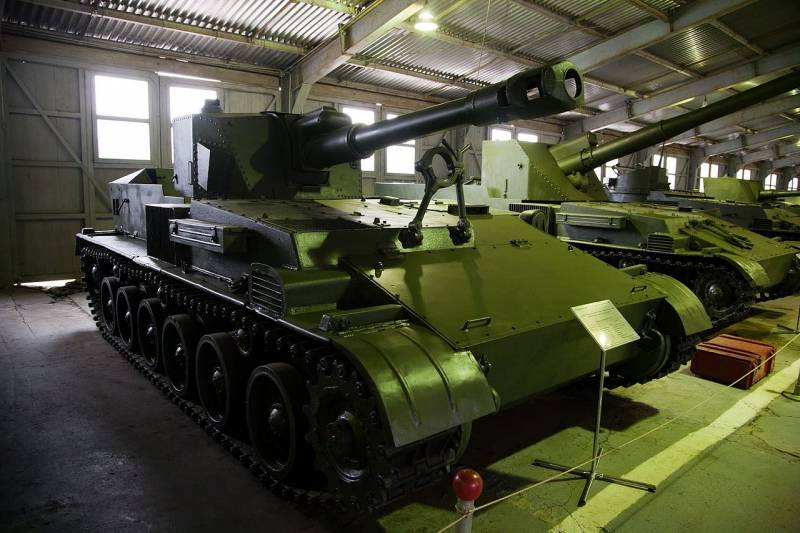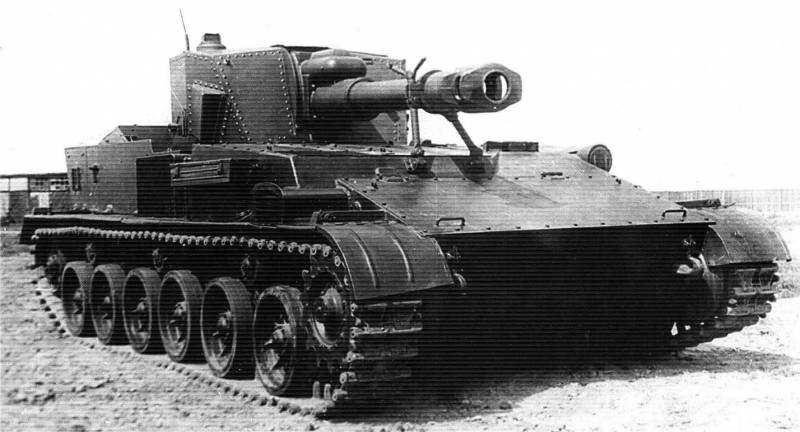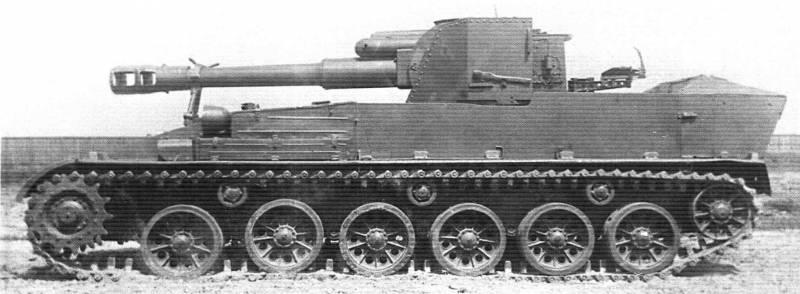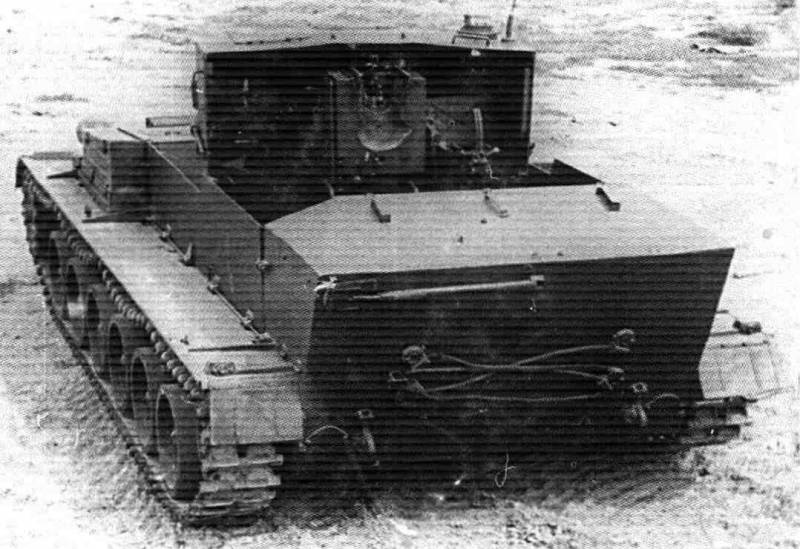Self-propelled artillery installation SU-152Г
The appearance of new projects contributed to the analysis of captured trophies and found German documentation on the subject of self-propelled artillery. At the final stage of the war in Europe, German engineers worked out various options for self-propelled guns of a semi-open layout and even managed to get some results. The Soviet military became interested in this concept and initiated the development of their own similar projects. Corresponding instructions appeared in the middle of 1946.
In August of the same year, department No.3 (OKB-3) of the Uralmashzavod enterprise (Sverdlovsk) presented two preliminary projects of promising self-propelled guns of a semi-open layout. They received the approval of the military and were recommended for further development. The study of various issues and the study of new concepts lasted for about two years, after which the Ministry of Defense initiated the full development of several promising projects for various purposes.
In accordance with the resolution of the Council of Ministers of 22 June 1948, specialists of Uralmashzavod, with the help of related enterprises, were to develop and bring to the test three samples of self-propelled artillery. It was necessary to create one machine, armed with a 100-mm cannon, and two carriers of 152-mm guns, one of which was planned to be equipped with a howitzer. Such a project received the working designation "Object 108". Subsequently, the car was designated as SU-152G. To simplify development and construction, it was decided to use a common unified chassis in three projects.
The development of all new projects, including SU-152G, was carried out in the design office Uralmashzavod under the direction of L.I. Gorlitsky. Other engineers have made a notable contribution to the creation of certain units. For example, at the stage of preliminary elaboration of the chassis, engineers A.M. carried out a great job of finding the best design solutions. Lehtzind and D.A. Geriev. To do this, they studied the design of all known and affordable armored vehicles of domestic and foreign production.
A characteristic feature of the three new ACS projects was the use of a common chassis. The requirements for the 108 Object project allowed the use of the body and chassis of the 105 Object / SU-100П self-propelled self-propelled gun without major changes to its design. In fact, the chassis of the two combat vehicles differed only in the equipment of the combat compartment, while all other units were the same for both projects.
As part of the new projects, it was decided to abandon some traditional ideas and solutions, which led to the corresponding result. In particular, several variants of the layout of the chassis armor were studied, and the unconventional for domestic technology was considered the most convenient. For the proper placement of all devices, it was proposed to locate the engine and transmission in front of the chassis, the engine compartment was located at the starboard side. To the left of it was located the command and control unit, and the large aft compartment served as a fighting compartment.
The final project included one of the considered variants of the case, which was distinguished by an optimal ratio of protection and mass parameters. It was proposed to build a hull consisting of rolled sheets of different thickness. Some of the joints were made by welding, and some were riveted. The most powerful frontal protection consisted of parts with a thickness of 18 mm. The least critical sections of the hull were covered with 10-mm armor. Such a reservation made it possible to protect the crew and internal units only from bullets and fragments.
The frontal part of the body had a wedge-shaped profile formed by inclined armor plates. Behind a larger top sheet there was a roof with a driver's hatch. To her left was the cover of the power compartment, differing slightly increased height. The hull had vertical sides of limited height. As the sides of the fighting compartment, folding armor plates of increased height were used. The stern of the hull was formed by an inclined rectangular sheet of relatively large height.
Protection of the fighting compartment was provided only by shield shield of the gun mount and low hull sides. It was proposed to use a shield of box-type construction, incorporating beveled front sheets and polygonal cheekbones, mounted at an angle to the longitudinal axis of the machine. There were also side details of a small width. Above the breech of the gun was a small roof, in which there were openings for the installation of optical instruments.
In the engine compartment of a reduced volume, the B-105 diesel engine was placed, which was a further development of the serial B-2. He differed power 400 HP and increased resource. Especially for the new chassis, an improved cooling system was developed with a radiator borrowed from one of the existing aircraft. The engine was connected to a mechanical transmission, located in front of the hull. The transmission included the main friction clutch for dry friction, a two-stream gear and turning mechanism, as well as two single-stage final drives. Power was given to the front-wheel drive wheels.
The new chassis for self-propelled artillery mounts received a tracked undercarriage, which had in its composition six support rollers on each side. Dual rollers with rubber bands were equipped with individual torsion bar suspension. The first and last pairs also had hydropneumatic shock absorbers. The drive wheels of the hook gear were placed in the front of the hull, the guides in the stern. The average diameter of the rollers required to equip the chassis with three pairs of support rollers. Following the SU-100P howitzer self-propelled gun received the first domestic caterpillar with rubber-metal joint.
In the middle part of the hull, near the front wall of the fighting compartment, there was a universal pedestal for mounting a gun mount. The “108 object” / SU-152G received an artillery unit equipped with an 152-mm howitzer, which affected its design. The guns' mounting mechanisms made it possible to fire at targets within the horizontal sector of 143 ° width with elevation angles from -5 ° to + 41 °. The tool was completed with hydropneumatic recoil devices. A part of the details of this system, which protruded beyond the limits of the frontal sheet of the shield cover, was closed by its own armored casing of a complex shape.
Self-propelled gun armed howitzer D-50 / D-1 caliber 152 mm with a barrel length 28 caliber. This gun was a modified version of the D-1 howitzer, initially performed in a towed configuration. The upgraded gun was equipped with a dual-chamber muzzle brake, a vertical semi-automatic wedge gate and a floating ejector. In view of the large mass of ammunition, the howitzer was supplemented with the unloading mechanism. Direct weapon It was proposed using telescopic and periscopic sights, as well as panoramas. The first ones were intended for direct fire shooting, the last one - for working in closed positions.
The gun used separate loading shots of existing types. It was supposed to use shells of several types, high-explosive, cumulative and smoke. When using high-explosive fragmentation projectiles, the maximum firing range reached 12,4 km. Cumulative flew 3 km. The self-propelled gun crew was asked to enter two loaders. Because of this, the combat rate of fire could reach 4-5 rounds per minute.
As in other family projects, the use of feed racks for the transport of ammunition was envisaged. Shells and cartridges for separate loading were located in boxes placed on the rear wall of the combat compartment. To protect against various external influences, these boxes were closed with several lids.
Staff additional weapons project SU-152G not provided. At the same time, the crew had to have personal weapons that could be used for self-defense in certain situations. A half-open cabin made it possible to use this weapon without special installations or installation tools.
The crew of the prospective ACS consisted of five people. In the single control department inside the building was placed a driver. Access to his place was through a sunroof. On the march, the driver could follow the road through the open hatch, in a combat situation a pair of periscope instruments should be used. The places of the four other crew members were in the fighting compartment. In front of it were the commander and the gunner. Chargers were located near the feed stacking.
The length of the armored vehicle “Object 108” in the hull did not exceed 6,5 m, the length with the forward cannon was about 7,5 m. The width was 3,1 m, the height was less than 2,3 m. highway speeds up to 23,8 km / h. Estimated power reserve was 65 km. The unified armored chassis had the ability to overcome various obstacles, with the exception of deep water bodies.
The development of the project “Object 108” / SU-152Г was completed at the beginning of 1949, after which all the necessary documentation was transferred to the workshop. In late spring, the workers of Uralmashzavod built the first prototype of the self-propelled gun. June 2 experienced SU-152Г together with the first SU-100П entered the factory tests, which took a little more than two weeks. During this time, the self-propelled gun howitzer went through the 865 test site and used up 139 shells, making two series of 88 and 51 shots. Armament and some other aspects of the project, in general, arranged the developers. At the same time, the existing chassis was far from fully complying with the requirements.
The reliability of the advanced tracked chassis left much to be desired, and it was sent for revision. It took only a few months to improve the existing design, but it did not meet the deadlines initially set. The improved experimental ACSs were able to be sent back to tests only at the beginning of 1950, after two postponements. State tests that took several weeks showed that the artillery part of the 108 Object complies with the existing requirements in terms of technical, combat and operational characteristics. At the same time, the chassis was considered incomplete, and the self-propelled gun was recognized not to cope with the tests.
Interesting, but not suitable for adoption, self-propelled units were again sent back for revision. This process took several years, and real results were obtained only in the mid-fifties. In the foreseeable future, once again the modified prototype SU-152G could again come to the test and show its capabilities. However, this did not happen. The plans of the military department have changed, and now they have no place for such self-propelled guns.
By this time, missile weapons of all classes not only confirmed their viability, but also demonstrated ample opportunities for solving various tasks. As a result, they received the support of the military and political leadership of the country, and also became a priority. The rapid development of rockets, supported by state leaders, nonetheless seriously hit other areas. In particular, in favor of developing new missiles, it was decided to abandon a significant number of new artillery systems projects.
In connection with the redirection of forces and resources to the rocket industry in the mid-fifties, it was decided to abandon all existing ACS projects of a semi-open layout. By this time, only one experienced 108 Object was built, and no further assembly of similar machines was planned. In connection with the new decisions of the command, this prototype remained in the singular. This combat vehicle has not been disposed of. Subsequently, she managed to become an exhibit of the museum of armored vehicles in Kubinka near Moscow.
Work on the three promising self-propelled guns were stopped, but the developments on these projects were not lost. Soon there was a proposal for another upgrade of the existing chassis in order to increase its carrying capacity. On the basis of such a machine, a large number of military, auxiliary and special equipment for various purposes was later created. Separate samples of this “family” are still used by the armed forces of our country and foreign countries.
At the same time, however, the development of self-propelled howitzer artillery stopped for some time. Only by the mid-sixties, the command, realizing the fallacy of previous decisions, initiated the launch of several new projects. When creating a new self-propelled artillery installations used already existing experience and previously proven ideas. For example, the 2C3 “Acacia” self-propelled howitzer received an armored chassis, similar to that used in the SU-100P and SU-152G projects, and was also equipped with weapons of the already developed appearance. Nevertheless, the SU-152G armored vehicle could not reach mass production, although it made a significant contribution to the further development of this direction.
Based on:
http://dogswar.ru/
http://otvaga2004.ru/
http://tankmuseum.ru/
http://strangernn.livejournal.com/
Solyankin A. G., Pavlov M. V., Pavlov I. V., Zheltov I. G. Domestic armored vehicles. XX century. - M .: Exprint, 2010. - T. 3. 1946 – 1965
- Ryabov Kirill
- Wikimedia Commons, Solyankin A.G., Pavlov M.V., Pavlov I.V., Zheltov I.G. "Domestic Armored Vehicles. XX Century"




Information